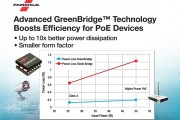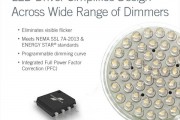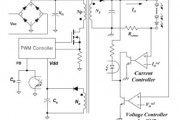 2016-07-26
2016-07-26
Fairchild a leading global supplier of high-performance semiconductor solutions, today enhanced its industry-leading GreenBridge™ active bridge quad MOSFET technology with FDMQ8205, the first member of its next-generation GreenBridge series for applications that receive power via Power Over Ethernet (POE), such as security cameras, wireless access points, LED lighting and other Powered Devices (PD). Designers can lower operating temperature, increase efficiency and reduce the solution size of their devices by taking advantage of the GreenBridge solution’s best-in-class Rdson performance, extremely small form factor and superior thermal performance.
Continue reading →
2016-05-23
Fairchild (NASDAQ: FCS), a leading global supplier of high-performance semiconductor solutions, introduced the newFL77944, the first solution in its LED Direct AC Drive family of solid-state LED lighting solutions that manufacturers can use to easily scale power and create smart and scalable LED-based lighting products that can be smaller, have higher performance and a longer system lifetime compared to products using the switch mode power supply (SMPS) approach.
Continue reading →
 2016-03-25
2016-03-25
In phase-cut dimming systems, a key technical issue has been mostly TRIAC holding current maintenance with low power LED lamps. In order to continue TRIAC conduction until the line voltage zero crossing, there have been several trials to flatten the driver input current higher than the holding current. In the previous compensation methods to provide constant input current, the input current is not precisely constant with a compensation error.
Continue reading →
 2015-02-05
2015-02-05
Fairchild, a leading global supplier of high-performance power semiconductor solutions for making the world a cleaner and smarter place, today announced the FL7734 Phase-Cut Dimmable Single- Stage LED Driver, a highly integrated LED controller solution for low-cost, and highly reliable LED lighting solutions from 5 W to 30 W. The FL7734 enables designers to quickly achieve great light quality designs with high dimmer compatibility while integrating full power factor correction (PFC) circuitry to meet power factor (PF) and total harmonic distortion (THD) requirements.
Continue reading →
2014-11-17
Fairchild, a leading global supplier of high- performance power semiconductor solutions for making the world a cleaner and smarter place, today announced the FL7733A Single Stage Primary-Side-Regulated (PSR) Flyback LED Driver for delivering constant brightness and instant flicker-free turn-on of LED lighting. The new low-power LED lighting driver is built for a variety of 5W to over 60W, indoor and outdoor LED applications so that designers can easily overcome the challenge of meeting global standards and regulations for LED lighting with a single, scalable solution.
Continue reading →
 2014-04-02
2014-04-02
The consumer electronics market, and the LED driver market in particular, have been developing rapidly in recent years. These markets are demanding power supplies/drivers with lower power consumption in shrinking form factors, as well as ultra low cost. Furthermore, due to the ever-increasing requirement for improved power quality, the use of power factor correction (PFC) circuitry for these devices is almost mandatory.
Continue reading →
2010-08-13
Small Footprint, 1mm2 Boost Switch Saves 60 Percent Board Space in Smartphone Designs
Continue reading →
2010-06-03
Fairchild Semiconductor introduces two LED drivers, FAN5701 and FAN5702. Both them deliver 92 percent peak efficiency, extending battery life. The company said they are designed for mobile handsets, gaming devices, MP3 players and other small display applications.
Continue reading →
2009-09-30
Fairchild Semiconductor brings designers of cell phones, medical, portable and consumer applications a boost switch that provides high efficiency in boost conversion circuits. The FDFME3N311ZT combines a 30V integrated N-Channel PowerTrench® MOSFET and Schottky diode for exceptionally low input capacitance (55pF typical) and total gate charge (1nC) to improve efficiency in DC-DC boost designs.
Continue reading →
 2016-07-26
2016-07-26
 2016-03-25
2016-03-25
 2015-02-05
2015-02-05
 2014-04-02
2014-04-02